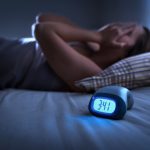What is CBT for Insomnia?
Posted by Colleen Carney

There are two main scientifically proven treatments for insomnia disorder. The first treatment is an approved sleep medication, and the second is a treatment called cognitive behavioural therapy for insomnia (CBT-I). Approved, effective sleep medications in Canada include zopliclone or benzodiazepines such as temazepam. These drugs have proven to be effective for some, but there are risks associated with them, and they are not intended for long-term use. The frontline recommended treatment for insomnia is not a pill, but instead a program that leverages your sleep system via behavioural change, that is: CBT-I.
What is CBT-I?
CBT is a system of therapy that teaches you to consider alternative ways of thinking about problems or alternative strategies to improve your health. CBT for insomnia is a treatment developed from research on what we know turns an occasional sleep problem into a chronic one. Although anything can cause insomnia as an occasional symptom (e.g., stress), there are several main factors that tend to take over to turn an insomnia “symptom” into an insomnia “disorder”. Research has told us that the things that make insomnia a chronic problem are:
- Increased rest suggests to our system that less deep sleep is needed
- An irregular schedule confuses the “body clock”
- The bed becomes paired with wakefulness
We can use what we know about sleep science to create behaviours that can provide better sleep. First, let’s talk about sleep science.
How do we make up for lost sleep?
One important thing we know from sleep science is that we make up for lost sleep with increased deep sleep, not more sleep. So, after a bad night, if you do not sleep longer, you may assume your body is not making-up for the sleep loss. This can create anxiety and frustration, as well as a belief that the body is not working. But if you know the whole story, it can help. The system that compensates for sleep loss monitors how much rest and activity is occurring. When you rest more or spend more time in bed, the body determines that less deep sleep is needed. Less deep sleep drive could make it harder to fall asleep, make you may wake up and have difficulty falling back to sleep, or sleep may feel light. The opposite is also true, that is, when you are very active or you spend very little time in bed, this system produces greater amounts of deep sleep. Knowing that this is how it works can be very useful. Someone with insomnia disorder may try to make up for lost sleep by resting more, trying to nap, going to bed earlier, or laying in bed longer in the morning. All of these behaviours amount to a message to produce LESS deep sleep, not more. We need to increase activity and decrease time in bed to get deeper sleep. CBT-I can help you calculate the optimal amount of time to spend in bed, sending a message to your system to produce more deep sleep.
How do we ensure our body clock runs optimally?
A second useful piece of sleep science we use in CBT-I relates to your body clock. Your body is constantly monitoring for cues in the environment or in your behaviour to align itself with the local time. In the example above, as someone experiences insomnia, they often try to make up for lost sleep by going to bed early, cutting back on regular activities, or lying in bed in the morning; all of these behaviours produce irregular sleep and wake times, which confuse the body clock. Irregular times are what produces the jetlag like symptoms of difficulty sleeping or getting up and mental/physical fatigue. Irregular times produce jetlag without travel and it becomes difficult to experience sleepiness right before bed and alertness right after waking-up. CBT-I determines the optimal (and regular) times for activities such as getting into and out of bed, so you have an easier time falling asleep and waking-up.
How do we turn off the alertness produced by our bed?
Ironically, when you experience a bad night, the bed can become associated with wakefulness. This new association (of the bed with wakefulness, rather than sleep) occurs outside of your awareness. How do you know if this pairing has occurred? Do you feel sleepy outside of the bedroom but as soon as you get into bed, you feel wide awake? If the answer is yes, your bed has become paired with wakefulness. CBT-I will undo this association by providing a list of strategies to encourage you to be in bed only when asleep, or pretty close to it. CBT-I also teaches you strategies to quiet your mind; used in conjunction with these other sleep science techniques.
Getting help
Are you interested in learning more about CBT-I or wonder if it is something you want to try? There are several options for CBT-I including self-help books (e.g., Goodnight Mind: Turn Off Your Noisy Thoughts and Get a Good Night’s Sleep), online programs (e.g., a free program for teens is www.dozeapp.ca) or talking to a CBT-I provider (for a list of Canadian CBT-I providers see https://css-scs.ca/wp-content/uploads/2020/10/provider-map.jpg).




